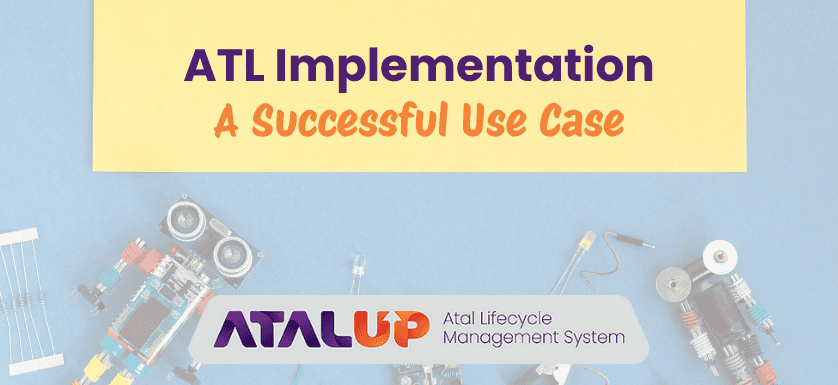
From just 100 activities in six years to an astonishing 3,158 in just 27 days- how ATALUP transformed a renowned Pune school’s ATL into a powerhouse of innovation.
Atal Tinkering Lab implementation demands efficiency, dedication, and a systematic approach. NITI Aayog reviews each lab’s performance periodically to analyse the efficiency and effectiveness of the initiative.
A renowned school in Pune was facing challenges in implementing the Atal Tinkering Lab. ATALUP team visited the school to understand their challenges and offer a concrete solution. In this blog, we are going to walk through the journey of this school towards successful Atal Tinkering Lab implementation.
Table of Contents
Challenges in Atal Tinkering Lab Implementation
The school space, intended to foster innovation and problem-solving among students, was struggling with inefficiencies that hindered its full potential.
Disorganised Material
ATL materials were scattered across the lab, making it difficult for students and educators to find the right tools when needed. The lack of proper arrangement led to wasted time and reduced engagement.
Improper Storage
Kits were mixed up, with components from different sets stored together. This confused, making it difficult to conduct structured activities and experiments.
Lack of Documentation
The school had no proper manuals or records for the kits. Without clear instructions, students and teachers struggled to utilise the available resources effectively.
Limited Resource Visibility
The absence of an inventory system made it hard to track available materials, leading to mismanagement and underutilisation of ATL resources.
Coordination Issues
Student participation was difficult to manage due to the chaotic state of materials. Ensuring the right tools were available for each activity was a major challenge.
These inefficiencies slowed down ATL activities, limiting student engagement and reducing the impact of the program.
Structured Improvements in Implementing ATL
To address these issues, ATALUP introduced a systematic approach aimed at transforming the ATL into a structured, high-functioning innovation hub. Our methodology focused on organisation, accessibility, and efficiency.
Sorting and Labeling
We organised all materials, placing each kit’s components in their designated spaces. To ensure easy identification, we took photographs of each kit’s contents and created a printable format listing all components. These were attached to the respective kits for quick reference.
Kit-Specific Labeling
Stickers were applied to all kits, ensuring each component was placed correctly. This eliminated confusion and streamlined access to materials.
Defining Activities
We outlined activities for each kit, enabling students to understand and execute experiments more efficiently. Clear instructions allowed seamless usage of available resources.
Introducing a Systematic Process
A structured system was implemented for students, teachers, and lab assistants. We created guidelines for material handling, cleaning, and scheduling, ensuring smooth ATL operations.
Transformational Impact
The impact of these changes was immediate and remarkable. Before our intervention, the school’s ATL had completed only 100 activities in 6 years. Following our structured improvements, the number of activities skyrocketed to 3,158 within 27 days.
Two Daily Sessions
The lab started running two sessions daily, ensuring maximum student participation.
50+ Activities Per Session
Each session saw an average of 50 activities, significantly increasing engagement.
Optimised Utilisation
The lab’s resources were now fully optimised, allowing students to explore STEM concepts effectively.
ATALUP: The Future of ATL Management
This transformation aligns with our vision at ATALUP, where we focus on making ATLs more efficient, accessible, and impactful. By implementing structured processes, inventory tracking, and guided workflows, ATALUP ensures that every school with an ATL can maximise its potential.
Our structured approach covers every phase of the ATL journey:
Apply – Helping schools secure funding for ATL setup.
Transform – Setting up a well-organised, fully functional ATL.
Automate – Implementing smart inventory and scheduling systems.
Learning – Providing structured STEM learning and engagement strategies.
Update – Ensuring continuous monitoring and improvement.
Progress – Creating a sustainable and high-performing ATL environment.
A New Era for ATLs in India
This transformation is not just about organising materials, it’s about unlocking the full potential of young innovators. With a structured and efficient ATL, students can explore, experiment, and innovate without limitations.
By adopting the ATALUP framework, schools can ensure that their ATL is not just a space with tools but an innovation ecosystem that encourages creativity, learning, and real-world problem-solving. Your school’s ATL can achieve more with the right structure, guidance, and system in place. Contact ATALUP for free consultation.